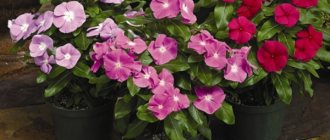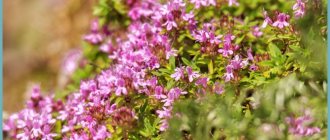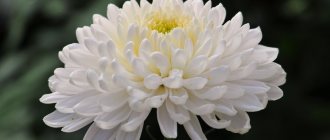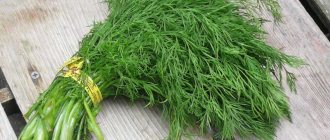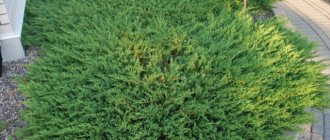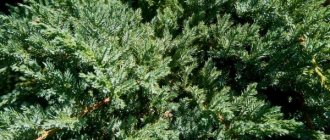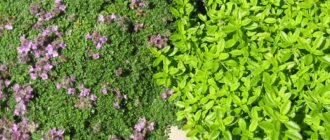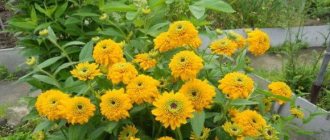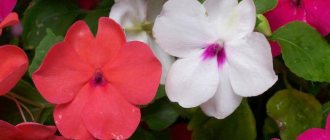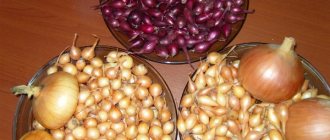A fashionable trend in landscaping garden plots and adjacent areas is the use of compositions with coniferous plants. They are durable, beautiful, and retain the decorative appearance of the crown at any time of the year. If previously the choice of crops for domestic gardeners was limited to pine and spruce trees, now many varieties are presented to the attention of gardeners and landscape designers: thuja, juniper, microbiota, fir, cypress, yew.
Juniper in landscape design is represented by several varieties, differing in the size of the bush and the shade of the needles. Ephedra is planted in the company of other ornamental plants, such as tapeworm, as a border crop.
Types and varieties used in landscape design
Juniper belongs to the Cypress family and includes more than 50 species. Some of them are tall plants, reaching 15 m. In landscape design, low-growing bushy and creeping juniper is used.
In the climatic conditions of our country, about a dozen plant species grow that are suitable for decorating a site.
Ordinary
Juniper or heather grows wild in our country. It can be seen in forests in European territory and Siberia. This is a frost-resistant, unpretentious conifer that can grow in sunny meadows and in the shade of tree crowns.
It does not have strict requirements for the soil. It can grow on poor sandy soils, podzolic soils, subject to regular watering.
Common juniper grows in the form of a shrub or tree with a cone-shaped crown. Its height can reach 6-8 m, but garden forms are limited to 1-2.5 m. The needles are hard, 1.5 cm long, green with a bluish coating.
The plant can be dioecious or monoecious. Propagated by seeds. Cone berries begin to form on the plant at the age of 7-10 years. Life expectancy is more than 400 years.
Common juniper has been cultivated in gardens since the 16th century; it is represented by hundreds of varieties of various shapes and sizes. Most Popular:
- Bruns (Germany) - a columnar tree with golden-green needles, resistant to rust;
- Columnaris - a narrow tree - a column, 200 cm high, bluish-green needles;
- Comfort - creeping form with a dense crown of rich green color;
- Mas (USA) – shrub with a cup-shaped crown, 100 cm high, dark green needles (bronze in winter);
- Repanda is a compact creeping bush, up to one and a half meters in diameter, with bright green needles.
Rocky
A species of conifer growing in the mountains of North America. The plant prefers rocky, dry soil and good lighting. The crown of the juniper can be columnar or rounded with irregular shape.
Rock juniper in landscape design is planted in rocky gardens and on alpine hills. Tall species do well in city conditions, planted in parks and squares.
The following varieties are suitable for cultivation in the Russian climate:
- Blue Heaven (pyramidal, blue needles, height 2 m);
- Moffett Blue (broad pyramidal, bluish-green needles, height from 3 m);
- Munglow (height 2.5 m and crown width 1 m, silver-blue needles).
Virginia
Ephedra comes from North America, where it grows on mountain slopes and among rocks. For this variety of juniper, choose areas illuminated by the sun, with loose loamy soil, neutral reaction. The presence of drainage in the soil is mandatory.
The juniper variety has average frost resistance. The crop should be planted in places protected from the wind.
Popular varieties of ephedra:
- Blue - a tree with a narrow column-shaped crown, blue in color;
- Gray - a low bush, with a flat spherical crown, gray needles;
- Hetz is a spreading bush, reaching 300 cm in diameter, the needles are light green.
Cossack
A compact shrub with scaly bright green needles (variegated forms exist), extremely unpretentious. Its height does not exceed 150 cm, the crown is in the shape of a bowl. The branches can rise up or grow horizontally. Cossack juniper grows quickly, forming dense thickets. Designers use this feature to create low hedges.
Ephedra is characterized by high winter hardiness, does not require frequent watering, and rarely suffers from diseases and pests. It has performed well in polluted environments and is used for landscaping city squares. It has the ability to purify and heal the air by releasing phytoncides into the atmosphere.
Arcadia is a dense dwarf shrub, up to 40 cm high and 200 cm in diameter. The needles are light green, sometimes with a bluish coating, and scaly.
Baksansky is a low-growing variety, with horizontal branches covered with bluish needles.
Can grow in lace shade, prefers high humidity. The variety is planted not only in open ground, but also in flowerpots. Golden-variegated - a variety with creeping branches, grown as a ground cover conifer. The needles are scaly, light green, with a golden tint.
Erect - a plant up to 2 m in height, with a pyramidal crown shape. The color of the needles is rich green. The form is drought-resistant, suitable for planting in urban areas.
Variegata is a variegated dwarf variety, up to 40 cm high. The shoots are creeping, covered with needles of greenish-yellow-cream shades. Requires planting in sunny areas, protected from wind and midday sun.
Chinese
This type of juniper is popular not only among gardeners. Since ancient times, masters of bonsai art have used Chinese juniper in their work. Ephedra is striking in its variety of forms: in nature you can find huge trees, more than 15 m high, and miniature forms 20-30 cm high. The needles of the plant can be scaly or needle-shaped; they are of a bright green hue. Young needles are tender and soft, but with age they become hard and sharp.
Juniper Cossack
As a rule, it grows in the form of a shrub up to one and a half meters high, but tree-like forms up to four meters in height are also found. It has blue-green needles of two types: in young plants - needles, which over time are replaced by scaly leaves. It has a characteristic pungent odor when rubbed due to the fact that it contains poisonous sabinol essential oil. The most famous varieties:
Femina is a shrub with a crown up to five meters wide and up to one and a half meters high. It has red-brown bark and dark green scaly leaves with an unpleasant odor.
- Capressifolia is a shrub with a wide crown and dense branches directed upward. Reaches half a meter in height. The needles are greenish-blue, mainly formed by scales, but needle-shaped ones are also found.
- Mas is a bush up to two meters high with a crown up to eight meters wide. The needles are needle-shaped, bluish-green, the bark is gray-red.
It is worth remembering that Cossack juniper is poisonous and eating any of its parts can be dangerous for humans and livestock. Therefore, you should be careful when planting it on the site.
Benefits and uses in landscape design
Decorative conifers are used by designers in styles that are characterized by strict geometric shapes combined with naturalness.
- The English or regular style is characterized by a perfectly flat lawn and large shapes. Large varieties of juniper are planted singly or in small groups. Pruning is actively used to give the plant shape.
- Japanese style involves a combination of conifers and stones, both natural and artificial. Japanese gardeners give preference to low-growing forms with an irregular crown shape.
Juniper will find a place in any garden; it can be planted:
- as a hedge or border;
- as a cover plant;
- plant in rock gardens and rockeries;
- with the help of juniper they strengthen crumbling slopes;
- Ephedra goes well with other plants.
Evergreen juniper is suitable for decorating the front area. Dwarf forms are suitable for the home garden.
Conifers are durable and unpretentious, which is a definite plus for site owners. Most types of juniper do not require pruning.
Combination with other plants
Juniper can be combined not only with other genera of plants, but also within a species. For example, columnar forms are lined with creeping varieties, playing on the different shades of needles.
Juniper looks beautiful in company with spirea, barberry, juniper (stone rose), saxifrage and sedum, heather and large grains.
As a background, juniper looks good for beautiful flowering plants: roses, lilies and daylilies, peonies, phlox.
The variety of forms of juniper and its unpretentiousness allows you to realize the wildest fantasies of a landscape designer.
Adding an article to a new collection
A wide variety of species and varieties, combined with unpretentiousness, have allowed juniper to gain favor among both professional landscape designers and amateur gardeners. And this is quite understandable.
Regardless of the size of your plot, there is always a place for this coniferous plant. Among the 75 species of juniper there are both low-growing creeping shrubs and giant trees. A rich palette of colors and a wide variety of crown shapes allow you to implement any design solutions.
Single landing
Tapeworms are trees and shrubs that grow separately from other plants. Their main task is to attract attention, which is why tapeworms were often planted near the estate. Such a composition, on the one hand, did not hide the house from passers-by, and on the other hand, it balanced the architectural dominant.
The plant can be absolutely anything; the main thing you should pay attention to when choosing it is its size and decorativeness. The height of an adult tree or shrub should be related to the size of the surrounding area as 1:3. It is a rare garden plot that can boast of dimensions that would allow it to be organically integrated into its design with a solitary planting with a poplar or a mighty oak, worthy of the attention of Andrei Bolkonsky.
At the same time, a wide selection of junipers leaves room for creative maneuver. Shrubs will help to arrange a small lawn, and trees are perfect for large areas.
Mixborders and multi-level compositions
Translated from English, the phrase “mixed border” is translated as mixed border. In landscape design, this is the name given to complex flower beds and flower beds that remain decorative from early spring until late autumn. Presentable appearance, which remains with the plant throughout the entire season, is an important criterion, which, however, not all plants fit.
A rich palette of colors and a large selection of shapes allow junipers to be used in compositions with a wide variety of ornamental crops. And not necessarily as a background for beautifully flowering ones. A large selection of colors and shapes makes possible combinations based on coniferous trees and shrubs with crowns of different shapes and decorative foliage annuals and perennials.
The best varieties
Since 1839, breeders have done a lot of work in developing new hybrid varieties of this crop, resulting in a variety of trees and shrubs that differ in appearance (shape, color and size).
Blue Arroy
One of the most popular junipers in Russia.
It has increased resistance to diseases and sudden temperature changes.
The crown is narrow, pyramidal, densely covered with soft needles. The needles are blue, with a grayish tint.
The height reaches 1.5-2 m, the circumference is about 0.5-0.7 m.
The plant is winter-hardy and drought-resistant, completely unsuited to growing in dirt and gas pollution. When planting, you should choose a place with clean air - away from roads and gas-polluted areas.
Sky Rocket
Forms a beautiful cone-shaped crown, densely covered with branches and needles. The shoots grow vertically, tightly adjacent to the central conductor.
The needles are green-blue, with a grayish tint. The dimensions of an adult tree are 3-6-0.7-0.8 m.
This crop tolerates gas pollution well, has high frost resistance, but weak immunity against fungal and viral diseases.
Blue Heaven
A medium-sized shrub up to 2 m high is one of the most decorative varieties with a dense pyramidal crown and light blue needles.
The above-ground part of the conifer does not change color throughout the year.
Moonglow
Colorful conifer will add a bright accent to the garden.
Description:
- a medium-sized tree-like plant reaches 2.5 m, diameter is about 1 m;
- the color of the needles is bluish-silver;
- forms small cones of round or oval shape, dark brown in color.
A special feature of the variety is the highly decorative crown, which becomes brighter and more saturated closer to winter.
Juniper has two advantages: it grows and develops well in any type of soil and easily tolerates drought.
Moffat Blue
A large tree in maturity reaches 3 m in height, girth - 1 m. The needles are greenish-gray and do not change color all year round.
The plant has good resistance to severe frosts, but does not grow well in waterlogged soil.
Silver King
This conifer differs from other varieties in its miniature compact height of 0.6 m and lush spreading crown - about 2 m.
The dwarf tree produces thick, scaly blue needles that do not change even in winter.
Wichita Blue
Another decorative variety with a dense and dense crown up to 0.4 m high and a girth of 1.5 m.
Needles with a blue color and a silver tint are widely used in landscape design because they are easy to care for, have good frost resistance and resistance to disease.
Springbank
Rock juniper has a distinct central trunk covered with brown, rough bark.
The branching is sparse - the shoots grow in a horizontal position, with soft, thin, blue needles of a silvery tint.
The hybrid tolerates cold and sudden temperature changes in spring, and grows on any type of soil.
Pathfinder
Different varieties and growing zones
A fast-growing hybrid with silver-blue needles, it is ideal for forming a beautiful hedge. It has a wide pin-shaped shape.
The height of an adult tree varies from 3 to 6 m, the circumference is 1-1.5 m. The above-ground part is very dense, densely covered with shoots. The annual growth is about 30 cm.
A drought-resistant plant that does not require soil. It takes root well and tolerates the proximity of other ornamental crops in the garden.
Silver Star
A beautiful evergreen conifer - in adulthood it reaches 4.5-5 m in height. The main difference is the combination of needles of two tones - emerald on the inside and cream on the outside.
The variety has a columnar crown with vertically growing branches, its circumference is 1 m.
The plant is winter-hardy, tolerates drought well and grows on any type of soil.
Fischt
Multi-stemmed tree with an irregular rounded crown. The central conductor is covered with red-brown bark, the shoots are silvery or bluish-green. The needles are emerald, scaly, length - 12 mm.
The plant forms beautiful cones of a dark blue color with a bluish bloom, spherical in shape, 4-6 mm in size.
It is not demanding on soil and has a good degree of frost resistance.
Alpine slide
Compact junipers come to the rescue when you need to set up a rock garden. The size of most summer cottages does not allow the creation of large bulk compositions, but a small alpine “mound” can fit into the landscape of almost any flower garden.
Naturalness is the main criterion that you should focus on when arranging these decorative groups. Therefore, the appropriate place for them should be selected - the rock garden should fit harmoniously into the natural landscape. If your site does not have uneven surfaces that would allow the slide to fit harmoniously, keep in mind that it should not be placed in the center of the lawn.
Rockery
If we approach the issue from a professional point of view, then most of the compositions that domestic amateur gardeners call alpine slides are rockeries arranged on a hilly surface. Because rock gardens are flower beds “populated” with plants typical of the region of the same name.
At the same time, by deciding to arrange a rockery on your site, you remove this limitation and get the opportunity to create a unique plant composition. Junipers' natural habitat is hills and rocky slopes, so it's no surprise that these plants do well in man-made rocky landscapes.
Pyramid and cone-shaped tree-like junipers can be used as dominants. At the same time, creeping varieties will fill the space between the stones and emphasize the beauty of flowering plants.
Hedge and border
Representatives of this species grow very slowly, so juniper is not the best choice for those who want to get a tall hedge in the shortest possible time. But even this negative, at first glance, characteristic will play into your hands if you want to decorate a low fence or arrange a border. After all, the slower the growth of the bush, the less frequently it needs pruning.
The silver-blue dense crown of the scaly juniper looks very impressive in such compositions. Sprawling and fragrant Cossack juniper is often used for single-row wide borders. The dark green, almost gray, needles of juniper virginiana will help shade the composition over a large area.
Caring for rock juniper
Rock juniper is quite easy to care for, as it is distinguished by its unpretentiousness and resistance to urban conditions. But it should be taken into account that in the first years after planting the plant will grow extremely slowly.
Mature bushes need to be watered only during prolonged drought. However, juniper can be watered no more than three times during the season. Newly planted seedlings need to be watered more often. It is also recommended to spray the seedlings with lukewarm water, and this should be done in the evening.
This plant cannot be fed with organic matter. For young bushes, just one feeding is enough, which is done in April or May; for this they use Kemira-universal (20 grams per 1 bucket of water) or Nitroammofoska (30 to 40 grams per 1 square meter). Mature bushes do not need to be fed.
Caring for rock juniper in winter directly depends on the variety. If the bush has a columnar crown, then after a heavy snowfall it is necessary to remove the snow from it by shaking it off, otherwise the branches may not withstand such weight and break. In order to prevent injury to the branches, they must be tied with twine before heavy snowfall so that they are pressed against the trunk.
Transfer
If you transplant a juniper without following the rules, it can destroy it. The reason for the death of the plant in this case lies in severe damage to the root system. Adult large bushes have the hardest time replanting. What rules exist that allow you to replant a plant without severe damage? The most important rule is to maintain the integrity of the earth clod when digging up a bush, because it is in it that the plant’s root system is located.
It is recommended to replant in March–April or June–July, because it is at this time that the plant has maximum root-forming abilities. But still, in the summer it is better to refrain from replanting, since in the heat the needles evaporate a large amount of liquid, which leads to a significant weakening of the juniper, as well as a slowdown in its adaptation. In this regard, it is best to do replanting in the spring, but if time is running out, then you can move the bush to a new place in the fall during leaf fall.
First, dig a pit, and do not forget to take into account the size of the earthen ball of the bush. Then you need to make a good drainage layer at its bottom. Prepare the required amount of soil mixture with which you will fill the pit. When everything is ready, you can begin to remove the bush from the ground. To do this, you need to dig it up, not forgetting to step back from the trunk at least 50 centimeters. The juniper extracted with a lump of earth must be placed on a durable cloth or film, then it is carefully moved to a new planting site. You need to plant a dug-out bush in the same way as a seedling during the initial planting. The surface of the tree trunk circle must be covered with a layer of mulch, and do not forget that the transplanted plant needs protection from direct rays of the sun.
Planting and caring for juniper
Diseases and pests
Very often such a plant becomes infected with rust, which is a fungal disease. In an infected specimen, deep orange growths appear on the branches; they contain oil with a pigment whose composition is very similar to carotene. An infected bush loses its spectacular appearance, its branches begin to dry out. After a few years, such a bush dies. If you notice the first signs of rust, cut off and destroy all affected parts of the plant as soon as possible, and then treat the juniper with a fungicide. Experts advise in this case to use such effective drugs as: Bayleton, Skor, Rogor, Vectra and Tilt.
Also quite often, the juniper bush is affected by fusarium wilt (tracheomycosis). Its development is very often due to the fact that the plant is grown on excessively dense soil with high humidity. This disease affects the root system of the plant, which stops transferring nutrients to the above-ground parts of the plant. The fact is that the mycelium of the fungus grows into the vascular system of the juniper. In the affected bush, the apical shoots dry out first, their needles change their color to pale red. After some time, the disease affects the entire bush. It is almost impossible to detect the development of Fusarium wilt at an early stage, but if you notice that the apical shoots of the bush have turned yellow or red, then immediately cut off the infected branches and treat the plant and the surface of the soil underneath with a fungicide. For greater effect, experienced gardeners recommend replacing the top layer of soil with fresh soil mixture, which must be soaked in a fungicide solution. For the purpose of prevention, purchased planting material must be treated with Quadris, Fitosporin-M or Maxim, not forgetting about the earthen lump. If the seedling is not very large, then its root system must be immersed in Maxim’s solution for 2 or 3 hours.
Also, juniper may lose its spectacular appearance or even die from a disease called branch drying. You can understand that a bush is infected in the spring, its needles turn yellow and begin to die, at first this affects not very large areas, but over time the disease spreads to the entire juniper or to most of it. As the disease progresses, small fungal fruiting bodies will form on the surface of the bark and needles. A diseased bush should be treated as soon as the first signs of drying out of the branches are noticed. To do this, all branches with yellow needles should be cut off, and the plant itself should be treated with a fungicide solution. If the juniper is very seriously affected by the disease, it will have to be dug up and destroyed. For preventive purposes, it is necessary to spray the bush 2 times per season, namely: in the second half of April and in the last days of October, for this they use Tilt, Ridomil Gold MC or Skor.
Rock juniper can also become infected with brown schutte (the name is derived from the German word, which translates as “crumble”). The affected specimen's needles turn yellow and fall off. Most often, the disease makes itself felt in the first weeks of summer. If you look at infected needles in the last days of August, you will see on its surface the fruiting bodies of fungi that are ellipsoidal in shape and black in color. If the juniper is not properly cared for or grown in the shade or in a damp place, in these cases this disease will develop rapidly. Branches with yellowed needles must be cut off, and also remove all dead needles that have fallen on the site, then treat the specimen with Strobi, Skor, Quadris or Ridomil Gold MC. For preventative purposes, bushes should be treated with these preparations in mid-April and in the autumn before frosts begin.
Pests such as leafminer moths, scale insects, aphids, and spider mites can harm this plant. To get rid of aphids, the bush must be sprayed with Fitoverm solution, which is prepared according to the instructions. If a moth has settled on a plant, then it needs to be treated with Decis solution (2.5 grams per 1 bucket of water), and you can get rid of scale insects using Karbofos solution (70 grams of substance per 1 bucket of water), which needs to be used to treat both the bush itself and the surface of the soil underneath. Spider mites are afraid of acaricidal agents, for example: Karbofos, Aktellika, Aktara and others that have a similar effect.
Pruning rock juniper
Rock juniper does not need formative pruning, because its crown has a very impressive shape by nature. However, it needs sanitary pruning. How to prune a bush correctly? Pruning is carried out in early spring before sap flow begins, and a rainy day is chosen for this. All dried, injured, disease- or pest-damaged stems and branches, as well as those that are not growing properly, should be removed. If you want to even out the contours of the crown, then remember that you can shorten the branches and stems by no more than 20 mm, since the growth of this plant is only 10 centimeters per year.
Cutting and shaping ROCK Juniper SKYROCKET/ topiary / Lord of the thuja/
Topiary
It is curious that even among dwarf junipers there are no varieties with a hemispherical crown, but the necessary shape can be achieved with regular pruning. Junipers tolerate pruning well, so they are often grown as topiaries and bonsai.
Despite the obvious decorative value, some summer residents are in no hurry to plant juniper on their site. The reason for this is not only the unpresentable appearance that some varieties of this plant acquire in winter, but also its ability to spread rust in the area. Therefore, choosing a place for this plant should be approached responsibly.
Juniper has gained immense popularity in landscape design due to its unpretentiousness, as well as a wide variety of shapes and sizes. This article describes how it can be used to decorate your home plot, as well as park areas.
Description of rock junipers
This variety of shrubs belongs to the Cypress genus. The word “rocky” indicates the area of its natural growth – rocks. In nature, this group of plants is most easily found in North America. The seedlings were brought to Russia in the 19th century and gradually began to be actively cultivated due to the excellent properties of the wood.
The main feature of juniper trees is longevity. Some specimens of blue arrow juniper can grow for several hundred years.
The characteristics of the rock variety will provide invaluable assistance to beginners who decide to use it to create landscape compositions:
- In nature, the height of the plant can reach up to 16 m. But when cultivated on a personal plot, such indicators cannot be achieved - the bush can grow to a maximum of 13 m.
- The trunk diameter usually varies from 0.85 to 2 m. The exact numbers depend on the age and growing conditions. The bark is inherently layered. As for color, it can range from blue-green (in seedlings) to dark brown (in mature plants).
- In young bushes the crown has a cone shape, in older ones it is more round. Its formation comes from the base.
- The branches are densely covered with scaly needles.
- The fruits are represented by cone-shaped berries of a dark blue color with a bluish coating. After 2 years, a pair of seeds forms inside the fruit.
Over the course of a year, rock juniper grows only 20 cm. Pollination occurs by cross-pollination, which is due to the dioecy of this crop.
Why juniper
In general, coniferous crops began to be used for landscaping a site quite a long time ago, because they delight with their beauty at any time of the year. In the last few years, designers have also used juniper to decorate areas, since its unique appearance can significantly change the area being decorated. Its sizes, which combine both dwarf species and specimens reaching the size of full trees, are capable of combining a large number of decorating styles available to lovers of evergreen perennials.
Rules of care
In a good place, rock juniper will grow without active care. But to increase the efficiency of the process, it is better to follow simple recommendations:
- An adult specimen needs watering only three times per season, plus additionally in case of severe drought;
- in the case of a young sample, limit yourself to warm spraying in the evenings;
- Fertilize young growth with a universal preparation once a year, in April;
- adult juniper does not need fertilizing;
- Shrub pruning is required only to give it shape (in March);
- for successful wintering, press the branches to the trunk with a circular winding;
- It is better to cover autumn seedlings for the winter with non-woven material or spruce branches.
If you need to replant, be sure to keep the earthen ball on the root. It is safer to carry out the procedure in the spring. The easiest way to propagate juniper at home is by cuttings. Prepare semi-lignified shoots with heels in early spring. Keep them in a greenhouse for 2-6 months. After this, the seedling is ready for trial rooting, and after 3-6 years - for transplanting to a permanent place.
Juniper is sometimes attacked by harmful organisms. Common diseases: rust, fusarium wilt, drying out of branches, brown chute. Pests include scale insects, leafminer moths, spider mites and aphids. All this can be treated with a standard set of products from the store.
Rock juniper is interesting for its varietal diversity and decorative qualities. Its popularity is due to its adaptability to the domestic climate.
What varieties can be used for planting outside?
Cossack juniper, which is dwarf, is perfect for decorating rocky areas. This species is the most common and fastest growing, and therefore has gained great popularity among gardeners and professionals. Cossack juniper Variegata in landscape design differs from other varieties in that it extends along the ground, but at the same time its spreading crown has a stunning blue-green color and has a sharp pine smell.
Another good variety of creeping shrubs is the horizontal juniper, the needles of which have a deep gray-green color with a slight bluish haze. The plant reaches 0.5 m in height and is perfect for decorating the edges of borders. Also suitable for these purposes is the cup-shaped Siberian juniper, which has gray, prickly needles.
Note! One of the tall varieties that goes well with any crop is Chinese juniper, reaching up to 10 m in height. The range of shades ranges from different tones of green to golden yellow.
Juniper virginiana is also suitable, which, as a rule, is represented by tall columnar species.
An interesting option for planting could be the common juniper Hortsmann, the crown of which, as it grows, looks as if drooping, forming a unique plant shape.
Another type of common juniper, which is distinguished by its chaotic pyramidal shape, is Suetsica. This species reaches a size of up to 10 m in height.
Varieties of rock juniper with photos and names
Thanks to the work of breeders from America, a large number of varieties of rock juniper have appeared, and all of them are quite popular among gardeners. Below we will describe varieties that are suitable for growing in mid-latitudes:
- Blue Arrow . The height of the bush varies from 150 to 250 centimeters, the crown is columnar and narrow, its width is about 0.5 meters. The needle-shaped, scaly green-blue needles have a steel tint.
- Blue Haven . The height of the bush is approximately 200 centimeters. Its pyramid-shaped crown reaches 100 centimeters in width. The color of the needles throughout the year is light blue with a steel tint.
- Skyrocket . This winter-hardy variety is quite popular among gardeners. When the plant is 10 years old, its height will reach 3–6 meters. The columnar habit is narrow and slender. Straight stems are adjacent to the trunk. Greenish-gray needles are usually scaly. This variety is susceptible to fungal diseases.
- Moffat Blue . This winter-hardy variety has a dense, wide-pyramidal crown. The color of the needles is greenish-blue. The height of the plant is 3–6 meters, and the width of its crown reaches 100–130 centimeters. This variety cannot be grown in regions with a humid climate.
- Moonglow . This variety has many similarities to Blue Haven. The crown of the plant is wide-pyramidal. At the age of ten, its height is 250 centimeters, while the crown reaches 100 centimeters in width. The needles have a rich blue-silver color, which looks even brighter in winter.
- Silver King . The bush has outstretched branches. When he turns 10 years old, he reaches a height of only 0.6 meters with a crown width of 2 meters. Blue colored needles are usually scaly.
- Springbank . This variety is light-loving. The crown is narrow, columnar. The height of the bush does not exceed 4 meters. The ends of the stems are “disheveled”, shaggy. The thin needles are colored blue-silver.
- Table Top Blue . The crown shape is oval. The color of the needles is blue-silver. The ten-year-old plant reaches a height of 200 centimeters, with a crown diameter of 250 centimeters.
- Welch . The dense crown has a pyramidal shape. The needles are greenish-blue with a silver tint.
- Wichita Blue . The bush has outstretched branches, and the color of the needles is bluish-silver. At the age of ten, its height does not exceed 0.4 m, while the width of the crown reaches 1.5 m.
In addition to the varieties described above, gardeners cultivate the following varieties of rock juniper: Winter Blue, Tollesons Blue Whipin, Tollesons Green Whipin, Sutherland, Montvaid, Medora, Greenspire, Erecta Glauka, Gray Glim, Colorado Green, etc.
Cultivation and planting methods
Juniperus variegata is one of the most unpretentious and frost-resistant plant species. It can be planted in stony, rocky, acidic, and also oily soil. This juniper is perfect for shady places.
To plant a shoot, you need to dig a hole several times larger than its roots, then add drainage in the form of old loose bricks or small stones to the bottom. If the soil type is acidic, then it is worth adding lime or dolomite flour. You should definitely loosen the soil, then place the shrubs. Before this, it is advisable to treat parts of the plant with a solution of potassium permanganate. It would not be bad if the seedling had a closed root system. It must be placed in the planting hole along with a lump of earth from the pot. After this, the roots are covered with sand. Well, in the end, fill the remaining space with sawdust or tree bark, because this can protect against the appearance of weeds.
For horizontal juniper, loamy or sandy loam soil types are best suited. Otherwise, all planting rules for junipers are the same.
Important! The main thing is to ensure good soil drainage, since shrubs do not like stagnant water. Also, do not plant them in clay soil.
This species should be planted in the spring in a well-lit place.
Varieties of Chinese juniper are absolutely not shade-tolerant and will certainly die if planted in the wrong place. The ideal time for planting would be April or May, as well as the beginning of September.
In general, all types of shrubs require the same care and planting algorithm, but with the slight difference that some varieties are suitable only for specific soil types. And, despite the fact that most juniper varieties can grow in the shade, you still need to ensure constant sunlight.
For your information! In order for the seedlings to take root better, it is recommended to replace the soil around the roots with a sand-peat mixture.
Water the plant with special care. If it grows in a place where groundwater comes close to the surface of the earth, watering must be done so as not to flood the plant with water. In one season, it is worth providing the juniper with about 5 waterings. In the hot season, their number needs to be increased. In addition, the branches should be regularly sprayed with water to maintain the beautiful appearance of the needles.
Planting rock juniper
If you purchased a rock juniper seedling with a closed root system, then it can be planted at any time of the year except winter. If the seedling has an open root system, it is recommended to plant it in open ground at the very beginning of spring after the soil has been well warmed up, but sap flow should not yet begin.
If you strictly follow the agrotechnical conditions of this type of juniper, then caring for it will be quite simple. When choosing a site for planting, you should take into account that it should be open and well lit, and the groundwater should lie deep enough. If the variety is dwarf, then you should choose an area with poor soil for it, otherwise such a juniper will not be undersized. High varieties of juniper are recommended to be grown in nutritious soil. Also keep in mind that this plant needs a lot of space.
The size of the planting hole should be at least 2 times the volume of the seedling's root system. If the seedling is a dwarf variety, then a distance of 50 centimeters should be maintained between the bushes. When planting tall plants, leave at least 200 centimeters of empty space between the specimens; the fact is that after 10 years such a juniper begins to grow actively. At the bottom of the pit it is necessary to make a drainage layer, the thickness of which should be 20 centimeters; for this you can use crushed stone or broken brick. It is recommended to immerse the seedling along with the container in a container of water several hours before planting. In this case, you can carefully remove the plant from the container without damaging its root system. If you can plant a seedling along with a lump of earth, it will be much easier for the juniper to take root.
The seedling must be lowered into a pit, which is covered with a pre-prepared soil mixture consisting of peat, turf soil and sand (2:1:1). The planted plant needs abundant watering. After the liquid is completely absorbed into the soil, the surface of the tree trunk circle will need to be covered with an eight-centimeter layer of mulch (chips, peat, sawdust or pine bark). The root collar of a planted seedling should be level with the surface of the site.
Juniper in garden design
A summer cottage can be easily decorated using both creeping and upright growing varieties.
Flowerbed with juniper
Note! Coniferous plants are used in almost any landscape design style. The main thing is to take into account their compatibility with other plants, and also that junipers should grow at a distance of 1 to 4 m from each other, depending on the specific species.
When decorating a flower bed, many people wonder what to plant next to the juniper? There are many options. Hydrangea and juniper growing next to each other will perfectly complement each other. But juniper and pear are a very dangerous neighborhood, since the fruit tree can easily wither. Ephedra is a good place for the growth of rust fungus, which affects many crops. It is best to plant other plants along with it, for example, tulips, roses, daffodils, other conifers, dogwood, honeysuckle, etc.
In addition, juniper will look advantageous on alpine slides. For an English-style garden, you can choose pyramidal and columnar varieties. If you have the proper skill, the edges of the paths can be decorated with junipers on a trunk or placed such a beautiful shrub in the center of any compositions. A flowerbed with hostas and juniper would also be a good option.
Important! Dwarf species should be planted next to tall plants and, vice versa, so that they do not block the sun from each other.
Juniper for hedges
Compositions with juniper bushes are not limited to flower beds. You can also create hedges with your own hands, which will become an amazing variation of a fence. This creation looks good in combination with trees, such as birch, and also beautifully encloses the flowerbed area. Such a fence can also be created against a background of red brick.
To form it, you should pay attention to high-growing varieties of common, Virginia and Chinese junipers. But it’s worth remembering that the latter variety will have to be covered for the winter.
Important! To give the bush the necessary shape, you need to acquire garden shears and hedge trimmers. The sides are cut in May and September, but the top can be cut only after reaching 10 years of age.
Reproduction of rock juniper
Rock juniper can be propagated by young layering, cuttings or grafting. Cuttings are prepared in the spring; for this purpose, the semi-lignified upper shoots with a heel are cut off (this is a small piece of wood from the branch from which the shoot grows). Root cuttings in a greenhouse. Once they have taken root, they should be planted in a training bed. Depending on the plant variety and the age of the cutting, it can take 1.5–6 months to take root. It takes 3–6 years to grow it in school.
Only creeping forms are suitable for propagation by layering. The stem must be cleared of needles and fixed on the surface of the soil of the trunk circle, which must be prepared in advance. After 6–12 months they will be completely rooted. Rooted cuttings need to be cut off from the mother bush and planted in a training bed located in a shaded place for growing.
It is quite difficult to propagate this type of juniper by grafting, as it requires certain professional skills.
